Last updated on
Discover effective ways to eliminate the musty smell from your kitchen cupboards and maintain a fresh, clean space for storing your essentials.
Have you ever opened your kitchen cupboards and been hit with a musty smell? It’s not only unpleasant but can also affect the taste of your food. The cause of this odor is usually mold or mildew, which can grow in damp environments.
But don’t worry, getting rid of that musty smell is easier than you think! In this article, we will share some effective tips on how to get rid of the musty smell in your kitchen cupboards and keep them smelling fresh and clean. So let’s dive right in!
What's Inside
Identifying the Source of Musty Smell

The first step in getting rid of the musty smell in your kitchen cupboards is to identify its source. The most common cause of this odor is mold or mildew, which can grow on damp surfaces.
Check for any signs of water damage or leaks that may be causing moisture buildup inside the cupboards.
Another possible culprit could be expired food items that have gone bad and are emitting a foul odor. Take some time to go through all the items stored inside your kitchen cabinets and dispose of anything past its expiration date.
If you’ve ruled out both these possibilities, it’s also worth checking if there are any dead insects or rodents trapped inside your cupboard space as they too can create an unpleasant smell.
Causes of Musty Smell in Kitchen Cupboards
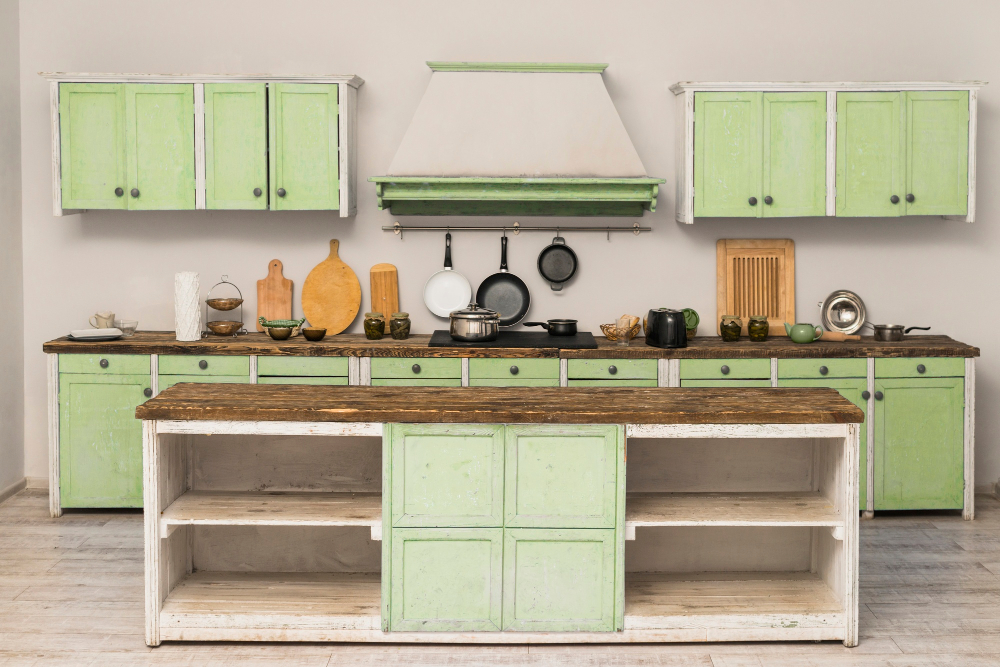
One of the most common causes is moisture buildup, which creates a damp environment that promotes mold and mildew growth. This can happen when there’s poor ventilation or if you live in a humid climate.
Another cause of musty smells is food residue left behind after cooking or storing food items for an extended period. The leftover particles attract bacteria and fungi, leading to unpleasant odors.
Old cabinets made from wood materials are more prone to developing musty smells over time due to their porous nature that absorbs moisture easily.
It’s essential to identify the root cause of the odor before attempting any cleaning methods as it will help prevent future occurrences.
Checking for Mold and Mildew
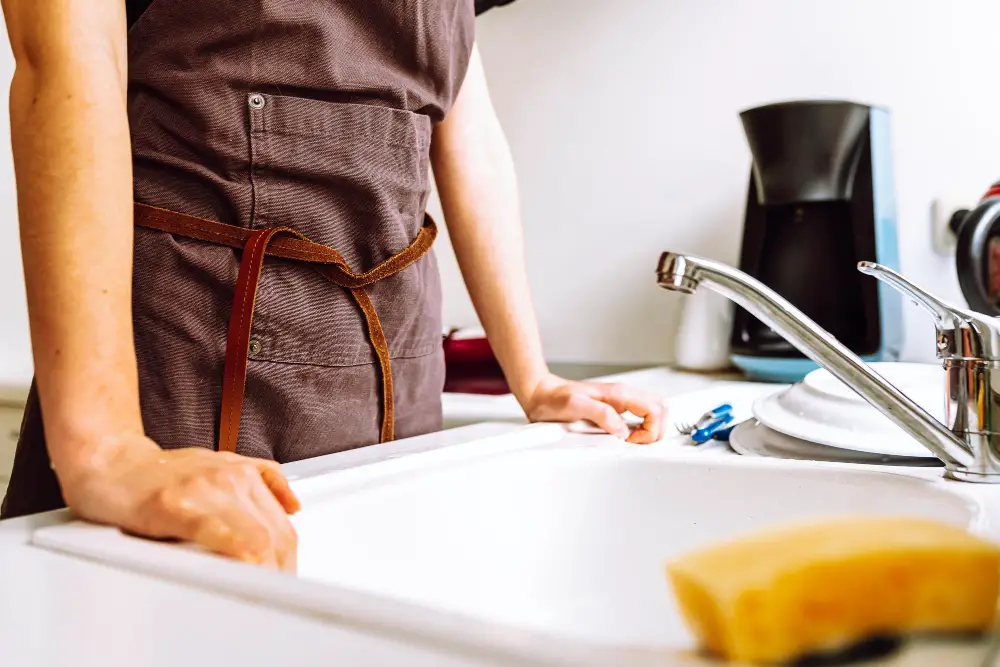
In most cases, it’s caused by mold or mildew growth due to moisture buildup. To check for mold and mildew, inspect your cupboards thoroughly and look for any signs of discoloration or black spots on surfaces.
Pay close attention to corners, edges, and areas that are prone to dampness such as under sinks or near pipes. If you notice any visible signs of mold or mildew growth, take immediate action before it spreads further.
It’s important not only to remove visible molds but also address hidden ones that may be lurking behind cupboard walls. You can use a flashlight and inspect inside cabinets carefully; if there is a strong musty smell coming from them even after cleaning them out properly then this could indicate an underlying problem with hidden molds.
Preventing Mold and Mildew Growth
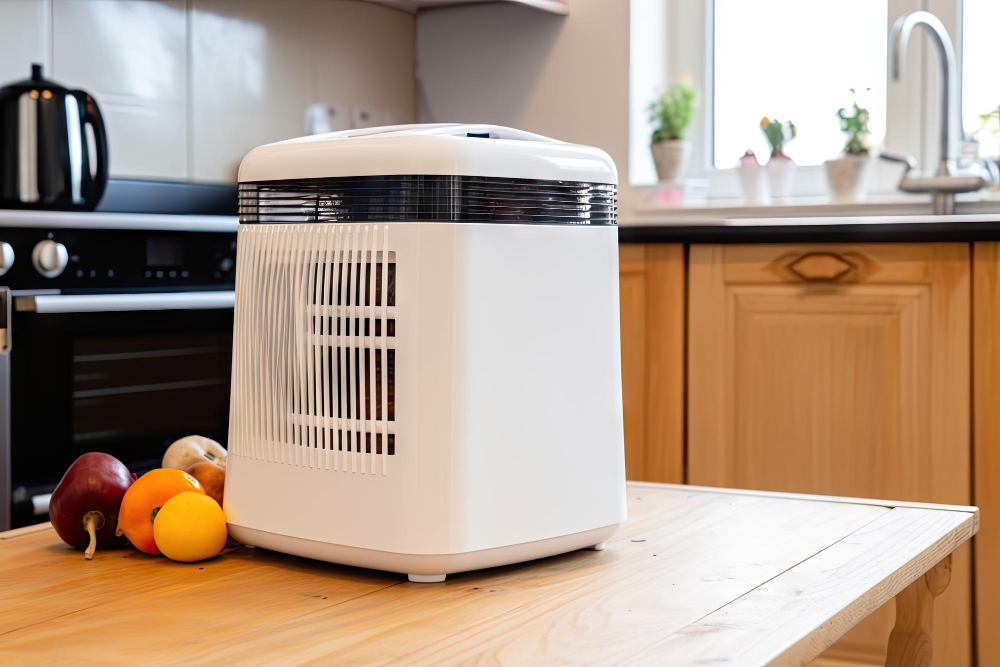
Here are some tips on how to do that:
1. Keep Your Cupboards Dry: Moisture is one of the main causes of mold and mildew growth, so make sure your cupboards stay dry by wiping up any spills or leaks immediately.
2. Use a Dehumidifier: If you live in a humid climate or have high humidity levels in your home, consider using a dehumidifier to reduce moisture levels.
3. Install Proper Ventilation: Good ventilation can help keep air circulating through your cupboards and prevent moisture buildup.
4. Store Items Properly: Make sure items stored inside cabinets are completely dry before placing them back into storage spaces; this will help avoid creating an environment for mold spores to grow.
Emptying and Cleaning the Cupboards
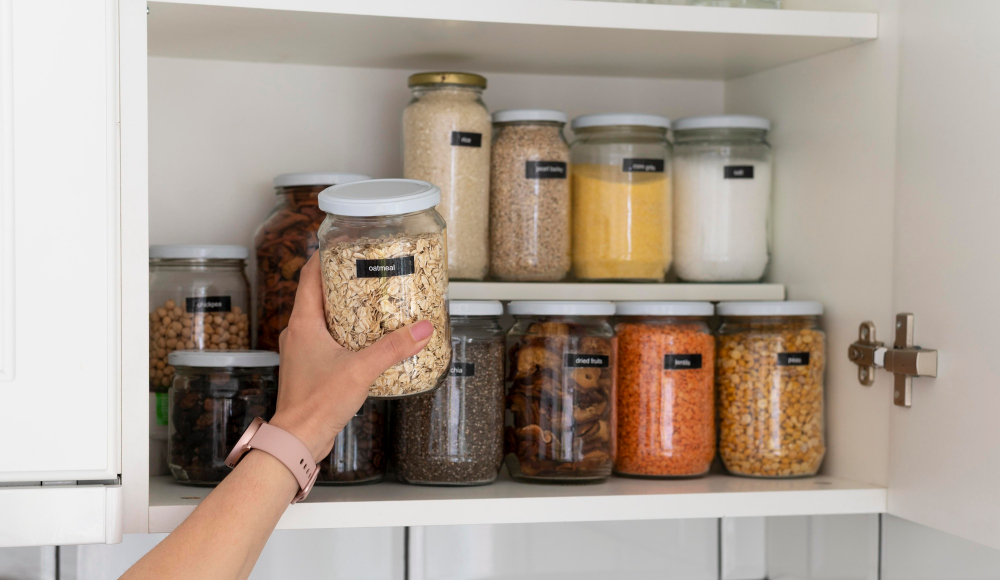
Start by removing all items from your cupboards and placing them on a clean surface. This will allow you to thoroughly inspect each item for any signs of mold or mildew growth.
Next, use a damp cloth or sponge with warm soapy water to wipe down the interior surfaces of your cupboards. Be sure to pay extra attention to corners and crevices where mold can easily grow unnoticed.
If there are any stubborn stains or areas that require deeper cleaning, consider using vinegar solution mixed with baking soda paste as an effective natural cleaner.
After cleaning is complete, let everything dry completely before returning items back into their respective places in the cupboard. It’s important not only for eliminating odors but also maintaining cleanliness in general kitchen hygiene practices.
Ensuring Proper Ventilation

Ensure that there is adequate airflow by keeping windows open or using exhaust fans while cooking or cleaning. If you have a range hood, make sure it’s functioning correctly and clean its filters regularly to prevent grease buildup.
Check for any obstructions around vents that may be blocking proper air circulation. It’s also essential to keep your cupboards organized so that air can flow freely through them.
Air Out Cabinets and Cupboards
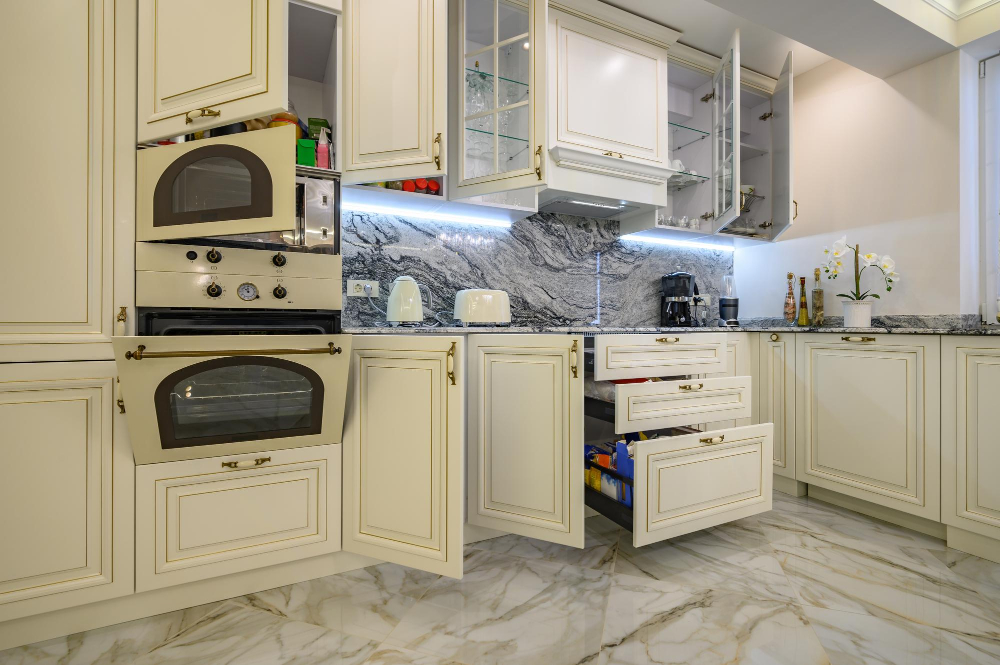
This method works best for mild cases where the smell isn’t too strong or persistent. Start by opening all cupboard doors and drawers, then leave them open for a few hours or even overnight if possible.
During this time, fresh air will circulate through the cabinets and help remove any trapped moisture that may be causing the musty odor. You can also place a fan near your cupboards to increase airflow and speed up the process.
If you live in an area with high humidity levels, it’s recommended that you air out your cabinets regularly to prevent mold growth from occurring in the first place. Make sure there are no leaks or water damage around your kitchen sink area as these can contribute significantly to dampness inside cupboards.
Using Baking Soda for Odor Removal
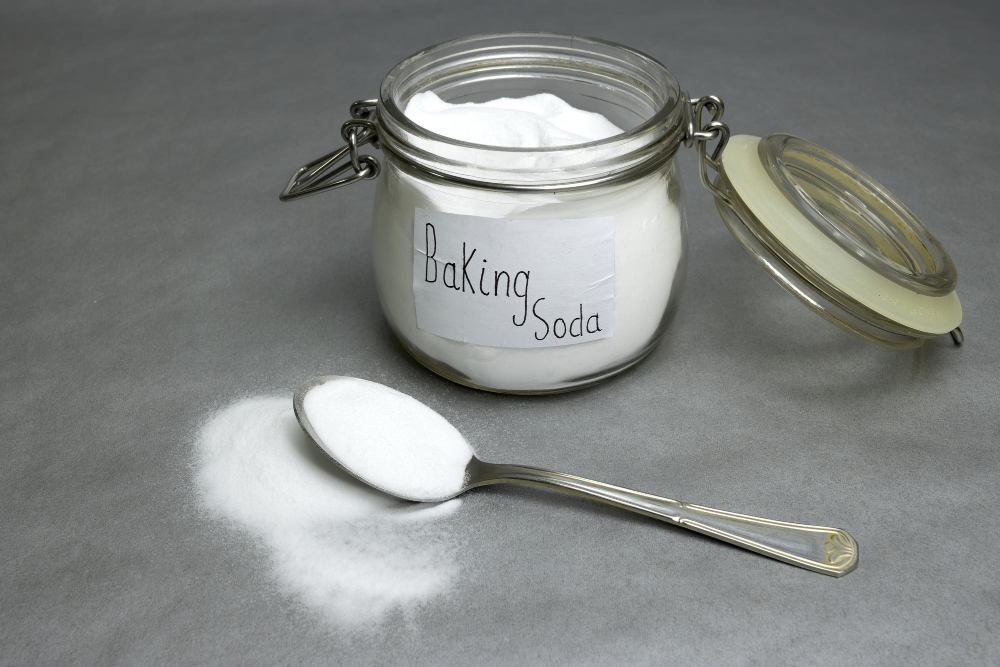
It works by absorbing moisture and neutralizing odors, leaving your cupboards smelling fresh and clean.
To use baking soda, simply sprinkle it generously inside each cupboard or drawer. Leave it on for at least 24 hours before wiping away with a damp cloth or vacuuming up any remaining powder.
For best results, repeat this process every few weeks to keep the musty smell at bay. You can also place an open box of baking soda in each cupboard to absorb any lingering odors over time.
In addition to its odor-eliminating properties, baking soda is also safe and non-toxic, making it an ideal solution for households with children or pets.
Using baking soda is a simple yet effective way to get rid of the musty smell in your kitchen cupboards without resorting to harsh chemicals or expensive products.
Implementing Vinegar Solution
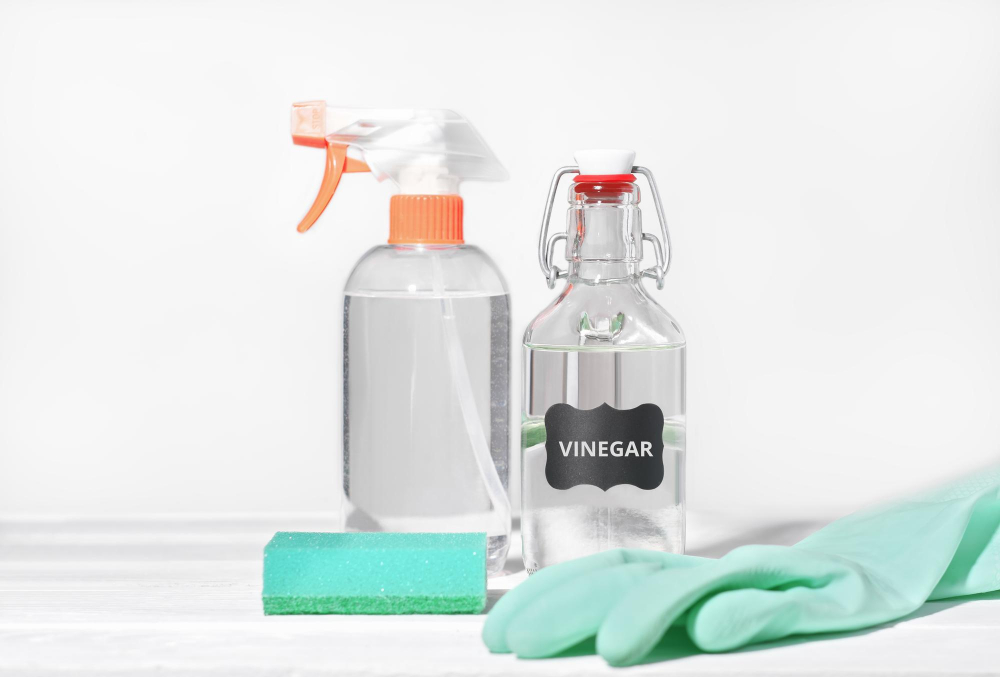
To use vinegar, mix equal parts of water and white vinegar in a spray bottle. Spray the solution inside the cupboards, focusing on areas with visible mold or mildew growth.
Allow the solution to sit for 10-15 minutes before wiping it off with a clean cloth. For stubborn stains or odors, you may need to repeat this process several times until they disappear completely.
It’s important to note that while vinegar is an effective cleaning agent, it has a strong odor of its own which may linger for some time after use. However, this scent will eventually dissipate leaving your cupboard smelling fresh and clean.
Applying Bleach Solution
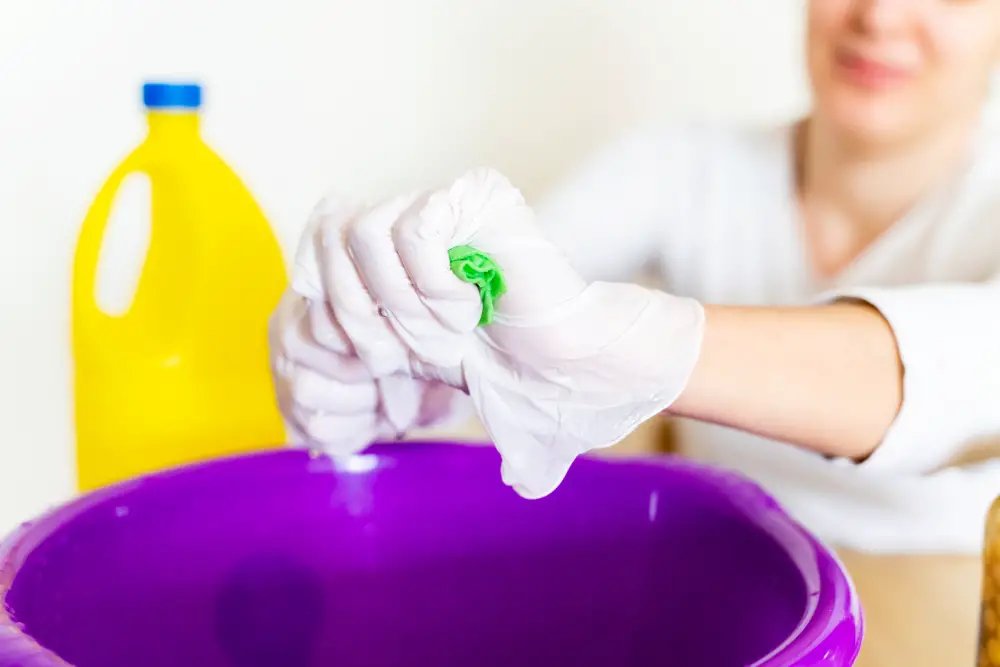
It should be used with caution as it can also damage surfaces and cause discoloration. Before using bleach, make sure to wear gloves and protective eyewear.
To create a bleach solution, mix one cup of bleach with one gallon of water in a bucket. Dip a sponge or cloth into the solution and wring out excess liquid before wiping down the inside of your kitchen cupboards thoroughly.
After applying the bleach solution, rinse off any residue with clean water and dry completely before placing items back into your cupboards.
It’s important to note that while using bleach may eliminate musty odors temporarily, it does not address underlying moisture issues that contribute to mold growth. Therefore, regular cleaning maintenance is necessary for long-term odor prevention in your kitchen cabinets.
Trying Lemon Juice and Water Mixture
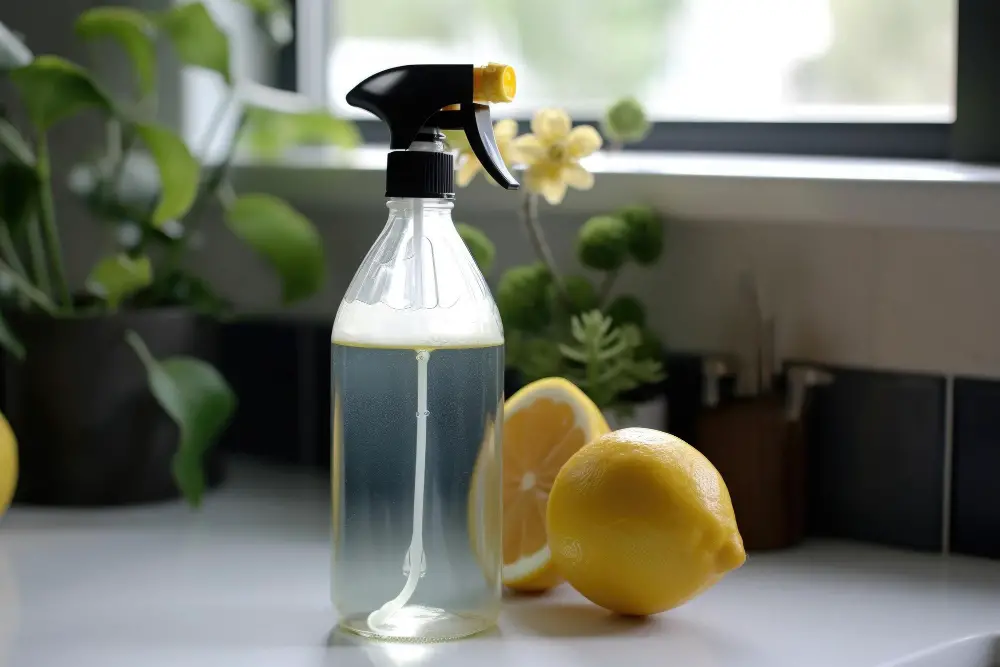
Lemon has natural antibacterial properties that can help eliminate odor-causing bacteria, while its fresh scent leaves a pleasant fragrance behind.
To make this solution, mix equal parts of lemon juice and water in a spray bottle. Spray the mixture inside your cupboards and let it sit for 10-15 minutes before wiping it clean with a damp cloth.
You can also leave some sliced lemons inside the cupboard overnight to absorb any remaining odors.
This method not only eliminates musty smells but also helps disinfect your cupboards naturally without harsh chemicals or artificial fragrances.
Utilizing Activated Charcoal
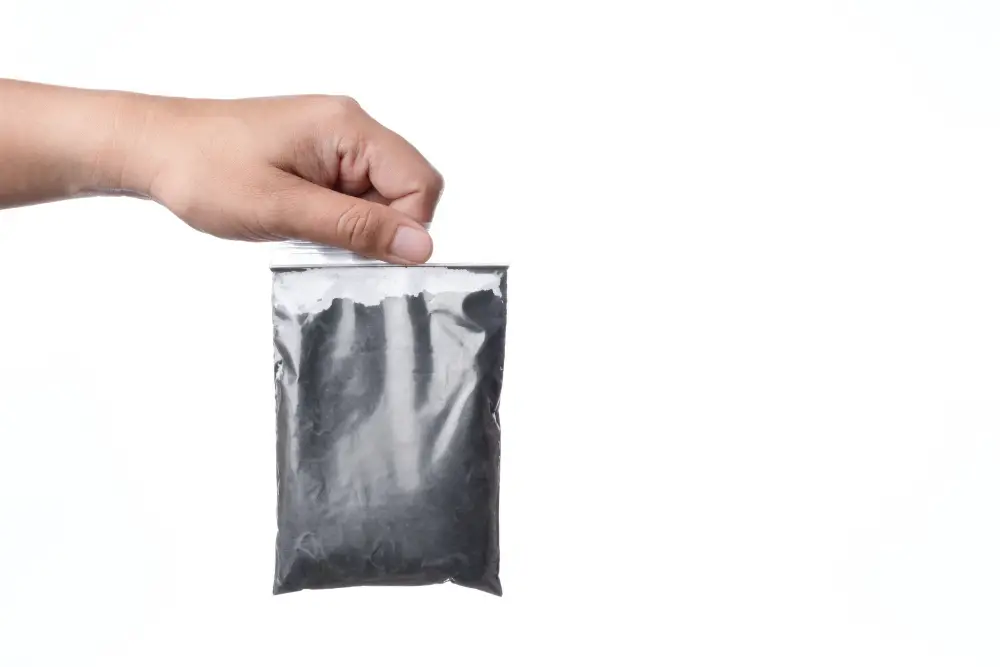
It works by absorbing moisture and odor-causing particles, leaving your cupboards smelling fresh and clean. To use activated charcoal, simply place small sachets or bags of it inside the cupboard for several days until the smell disappears.
You can purchase activated charcoal at most health food stores or online retailers. Alternatively, you can make your own sachets by filling small cloth bags with activated charcoal powder.
It’s important to note that while activated charcoal is safe to use in most cases, it may stain light-colored surfaces if it comes into contact with them. Therefore, be sure to place the sachets on a piece of paper towel or other protective surface before placing them inside the cupboard.
In addition to eliminating musty smells from kitchen cupboards, activated charcoal can also be used in other areas of your home such as closets and bathrooms where dampness may cause unpleasant odors.
Deodorizing With Coffee Grounds

The natural oils in the coffee grounds help absorb and neutralize odors, leaving your cabinets smelling fresh.
To use this method, simply place dry coffee grounds in a bowl or small container and leave them inside the cupboard for 24-48 hours. Afterward, remove the container and discard the used coffee grounds.
This is an easy and affordable way to get rid of musty smells without using harsh chemicals or spending too much money on expensive odor eliminators. Plus, you can reuse old coffee grounds that would otherwise go to waste!
In addition to deodorizing your kitchen cupboards with this method, you can also try placing open containers of dry ground beans around other areas of your home that may have unpleasant odors such as closets or bathrooms.
Placing Damp Rid Products
These products work by absorbing excess moisture from the air, which helps prevent mold and mildew growth. You can find Damp Rid products at most home improvement stores or online retailers.
To use these products, simply place them inside your cupboards and let them do their job. They usually last for several weeks before needing to be replaced.
One thing to keep in mind when using Damp Rid is that it’s important not to overuse it as too much moisture absorption can cause damage or warping of wooden cupboard materials. It’s best used as a temporary solution until you’ve identified and addressed the root cause of the musty smell.
Make sure you follow all safety instructions provided with any product you use in your home including keeping out of reach from children and pets.
Post-Cleaning Scent Infusion

There are several ways to do this, including using essential oils or scented sachets.
One option is to place a few drops of your favorite essential oil on cotton balls and tuck them into the corners of your cupboards. Lavender, lemon, peppermint or eucalyptus oils work well for this purpose.
Another way is by making scented sachets using dried herbs such as rosemary or thyme. Simply tie the herbs in small pieces of cheesecloth and hang them inside the cupboard.
You can also use commercial air fresheners designed specifically for cabinets and closets. These products come in various fragrances that last up to several weeks before needing replacement.
Remember not to overdo it with strong fragrances as they may overpower other smells in your kitchen space.
Sealing Cupboards With Polyurethane
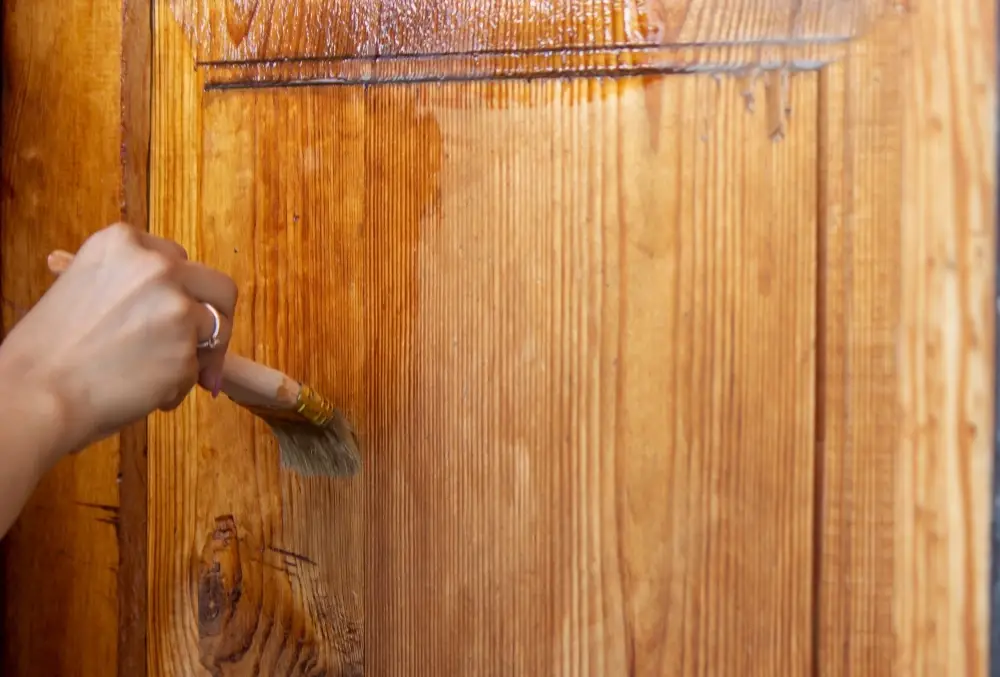
This is a great option if you suspect that moisture is seeping into your cupboards from outside or if there are gaps in the woodwork.
Polyurethane acts as a barrier against moisture and prevents mold growth. It also helps protect the wood from damage caused by humidity, which can cause warping or cracking over time.
Before applying polyurethane, make sure your cupboards are clean and dry. Sand down any rough spots on the surface of the cupboard doors or shelves so that they’re smooth before applying any sealant.
Once everything is prepped, apply two coats of polyurethane using a brush or roller. Allow each coat to dry completely before adding another layer for best results.
Addressing Persistent Odors

One way is by using an ozone generator, which releases ozone gas into the air and neutralizes any odor-causing particles. However, this method should be used with caution as high levels of ozone can be harmful.
Another option is to use a professional cleaning service that specializes in removing stubborn odors from homes. They have access to specialized equipment and products that are effective in eliminating even the most persistent smells.
It’s important not only to eliminate existing odors but also prevent them from returning by maintaining proper ventilation, keeping your cupboards dry at all times, regularly cleaning them out and ensuring they’re organized so air can circulate freely.
Cleaning and Maintenance Tips
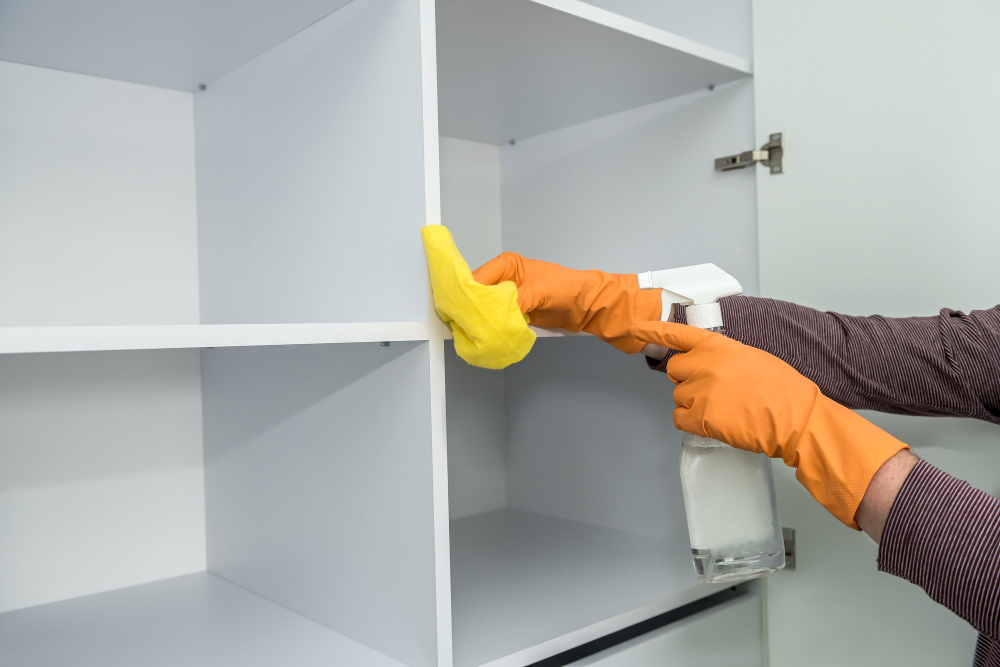
Here are some tips to help you keep your cupboards smelling great for longer:
1. Regularly wipe down the interior of your cabinets with a damp cloth or sponge.
2. Avoid storing wet items in the cupboard as they can cause mold growth.
3. Keep an eye on any leaks or water damage around the sink area, dishwasher, or refrigerator that could lead to moisture buildup inside cabinets.
4. Use shelf liners made of non-porous materials such as plastic or vinyl which can be easily wiped clean if spills occur.
5. Consider installing a dehumidifier in areas where humidity levels are high like basements and laundry rooms since excess moisture promotes mold growth.
Maintaining Cleanliness and Organization
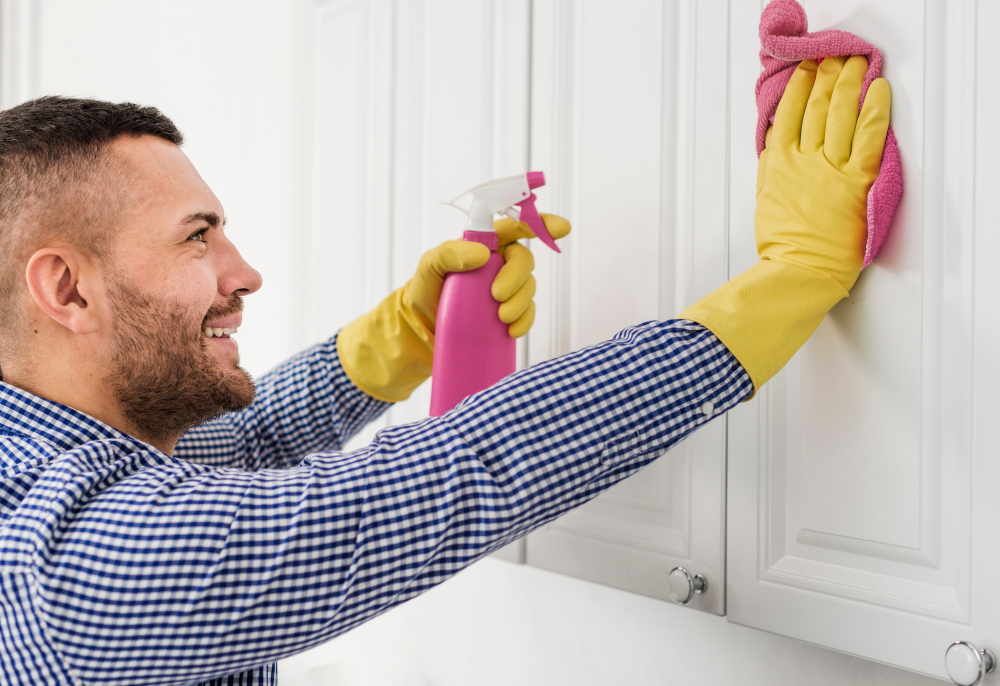
Start by wiping down your cupboards regularly with a damp cloth or sponge. This will help remove any dust or debris that can accumulate over time.
Next, organize your items in a way that allows for proper ventilation. Avoid overcrowding shelves as this can trap moisture and lead to mold growth.
Consider using shelf liners made of materials like cork or mesh which allow air circulation while protecting surfaces from spills and stains.
Lastly, make sure all food items are stored in sealed containers to prevent odors from spreading throughout the cupboard space.
Replacing Damaged Cupboard Materials
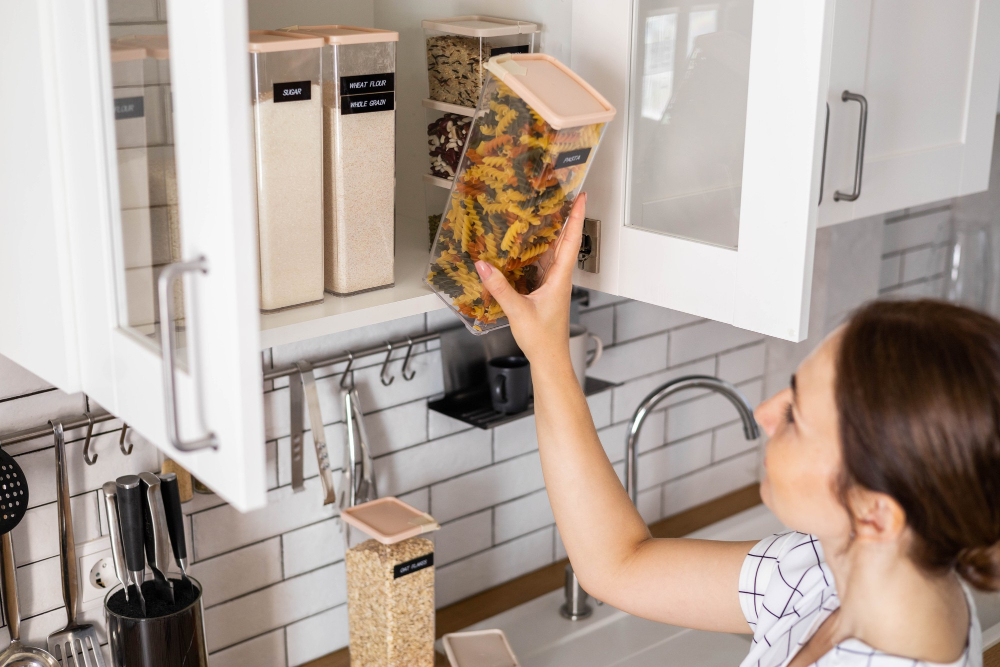
Over time, cupboard materials such as wood or particleboard can become water-damaged and start to emit a musty odor. If this is the case, replacing these materials will not only eliminate odors but also improve the overall appearance of your cupboards.
To replace damaged cupboard material:
- Remove all items from inside.
- Unscrew any hardware attached to doors or drawers.
- Carefully remove any shelves that need replacement.
- Measure and cut new shelves using appropriate tools (e.g., saw).
- Sand down rough edges on new shelves with sandpaper.
- Apply a coat of primer before painting or staining if desired.
By following these steps, you’ll be able to restore your kitchen cupboards’ functionality while eliminating unpleasant smells for good!
FAQ
Why do my kitchen cupboards smell musty?
Your kitchen cupboards smell musty due to humidity, excess moisture, and poor ventilation, which allows mildew to permeate, especially during winter months.
What absorbs bad smells in cabinets?
Vinegar and baking soda can absorb bad smells in cabinets when placed in a bowl overnight.
How do you get a bad smell out of wood cabinets?
To remove a bad smell from wood cabinets, mix equal parts of vinegar and water, dampen a cloth or sponge, and wipe down the furniture.
What are the most common causes of musty smells in kitchen cabinets?
The most common causes of musty smells in kitchen cabinets are moisture, mold, and mildew.
Are there any natural solutions for eliminating musty odors from cupboards?
One natural solution for eliminating musty odors from cupboards is by placing open containers of baking soda or white vinegar inside, as both substances absorb unpleasant smells effectively.
How can I prevent musty smells from developing in my kitchen cabinets in the future?
To prevent musty smells in your kitchen cabinets, ensure proper ventilation, use moisture absorbers, and regularly clean and air out the cabinets.




